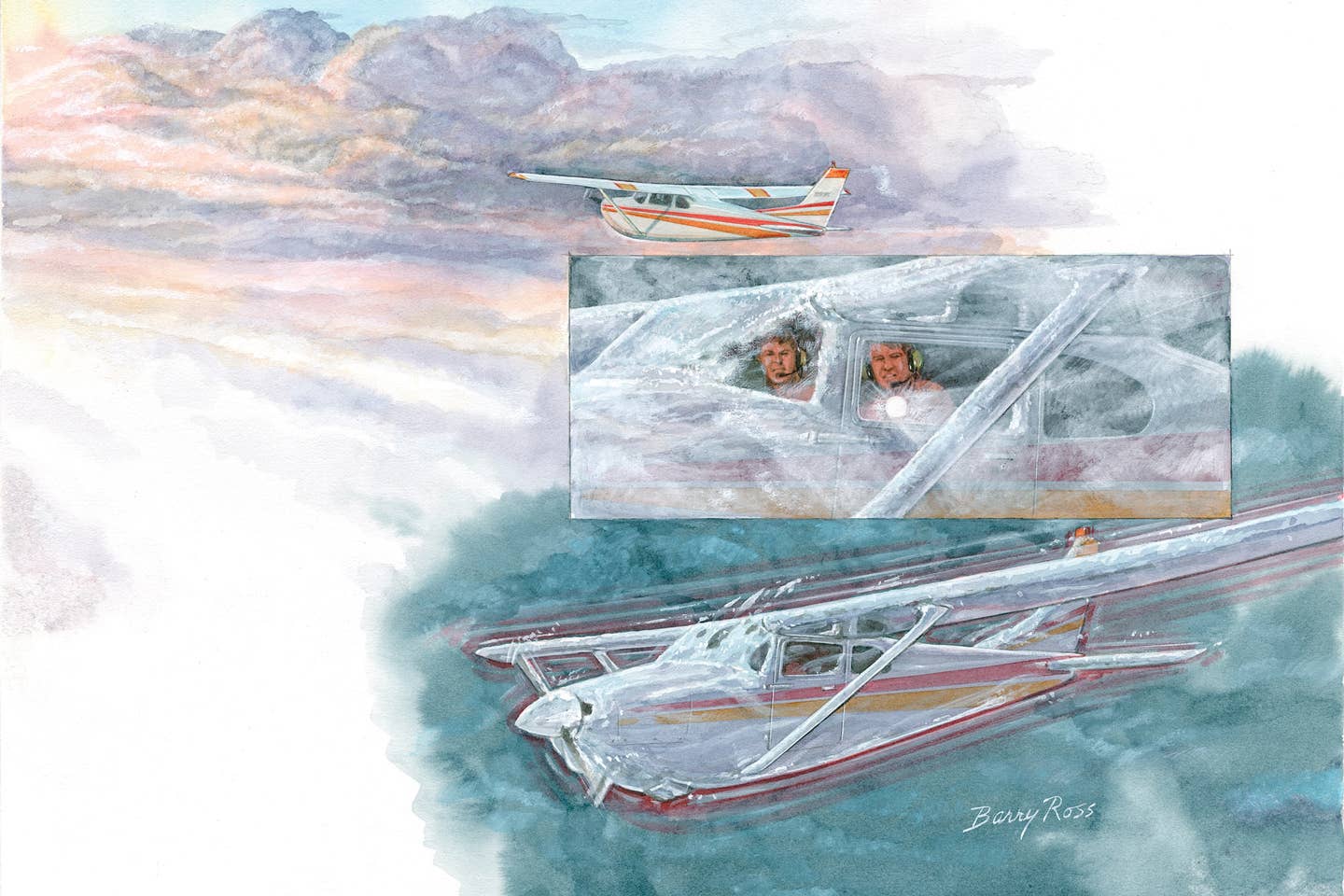
As we entered the clouds at about 13,000 feet, we immediately encountered horrendous icing, and the windshield defroster became ineffective very quickly. Barry Ross
In 1980, as a local banker for 15 years, I was asked by the bank’s directors to become more involved in community affairs—specifically, to take over the position of chairman of finance on the executive board of the Boy Scouts of America in our town of Greenwich, Connecticut. In that position, I was responsible for the finances of the organization, and much of my time was devoted to increasing its income in order to fund projects.
As a pilot with 400 hours under my belt, I decided to get creative and use the talents of others on our finance committee, which included a CPA and an advertising executive. We decided to inform every registered aircraft owner in the Northeast about the substantial tax advantage of donating their (mostly unused) aircraft to our organization and utilizing the IRS tax deduction allowed for the donation. In turn, we would dispose of the asset to create income to fund our community projects.
The advertising executive board member donated his agency’s time and talent to create a brochure picturing hundreds of aircraft parked in a line at our local airport, Westchester County Airport (KHPN) in White Plains, New York, with the caption: “Thinking about selling your aircraft?” We purchased a list of registered aircraft owners from the FAA and mailed out the brochures. The response was absolutely amazing—five aircraft in various stages of condition, ranging from excellent to unflyable were offered to us.
One of the letters we received was from a professor at one of the foremost colleges in New Jersey, who was getting close to retirement and wanted to donate his 1961 Cessna 210, which was located at his vacation-home airport in Marathon Key, Florida. We would have to fly down to Marathon Key commercially, and after giving us instruction on his 210, he would transfer the title to our organization.
It was January 1981 when the time came to depart for Marathon Key. I asked a friend—a young, newly minted CFI—if he would fly back with me to White Plains in the 210, and he agreed. We got a motel in Marathon Key and began the indoctrination with the owner on the nuances of the older Cessna 210. After a full week, we decided it was time to get going and return to White Plains.
After charging an almost-dead battery and discovering an inoperative voltage regulator, we filed for the airport at New Smyrna Beach, Florida. The CFI had worked for the FBO at that airport for the past three years, so we had little difficulty with the repairs. The next morning, we discovered that the weather along our route was absolutely horrific IFR—ice everywhere, with no hope of clearing up for days because of a stationary trough between us and our destination. After three or four additional days of waiting, we had terrible “get-home-itis” and decided to fly part of the way to Wilmington, North Carolina. The plan was to refuel and then punch through the trough with enough fuel to break out on the other side, hopefully, with much better weather.
The weather at Wilmington was IFR, and when we attempted to shoot the ILS back-course approach, we discovered that our localizer and glideslope had become inoperable. Fortunately, Wilmington had one of the few functional remaining precision approach radar procedures, and we made an uneventful approach and landing. While the airplane was being refueled, we met with a pilot who had just flown a single down from Washington, DC, and he convinced us the route home was doable—as long as we remained above the tops (which we were told by the briefer were at 9,000 feet).
After a detailed weather briefing, we were cautioned that getting into the clouds would be extremely hazardous without anti-ice equipment because all reports indicated heavy icing. We departed Wilmington with intentions of overflying the storm ahead of us at 9,000 feet and sat back for what we were convinced would be an uneventful flight. After only half an hour, and in order to remain clear of clouds, we had climbed to 11,000 feet and, subsequently, to 13,000, checking our fingernails every few minutes to see if they’d turned blue.
The sun was beginning to set when we spotted what looked like an impenetrable white wall, impossible to circumnavigate. Up to this point in the flight, we had to climb every hour or so to stay above the clouds without oxygen, but up ahead, there were cloud tops as high as we could see, with no chance to get above the severe icing.
We now had two choices: Try to get down through the severe icing to the nearest airport without picking up more ice than the airplane could carry and retain enough lift to stay in the air, or—the choice we decided on—to punch through the wall of clouds as expeditiously as possible and hope for dry weather on the other side. We were unable to return to Wilmington because of the short-range fuel tanks in the 210.
Read More: I Learned About Flying From That
As we entered the clouds at about 13,000 feet, we immediately encountered horrendous icing, and the windshield defroster became ineffective very quickly. I shone my flashlight on the wing strut and saw ice forming at an impossible rate. The pitot tube’s heat had been on the whole time but was now struggling to keep from freezing up, which was reflected in the sporadic airspeed indication, with the needle dropping to zero and then back to normal.
Things got worse from there, beginning with prop ice that caused enormous vibration of the engine and cowling. The engine’s oil-temperature gauge began to surge upward to the redline, and we knew the oil cooler had frozen over, and complete engine seizure was not far away. We opened the cowl flaps to full in an attempt to bring down the temperature. There was so much ice on the airplane and propeller, we could not maintain altitude. In that regard, having short-range fuel tanks and the associated lighter weight turned out to be a blessing. We called center and told them about our problem, and they gave us a block altitude.
We continued to pick up ice and could not remain inside the authorized block altitude. We saw no point in declaring an emergency because we were already receiving priority treatment, and there were no other sane pilots flying aircraft in this icing nightmare. We asked the controller for vectors to the nearest airport, which happened to be Salisbury, Maryland. We could see absolutely nothing out of the windows, had no airspeed indicator, could barely read the instrument indications because of the violent shaking, and could not maintain altitude.
At 6,000 feet, we heard a tremendous bang and then another. Large chunks of ice began breaking off the airframe and windshield, opposite the defroster, striking the empennage. We knew enough about control surfaces to know we needed to land very clean and fast, except for lowering the gear at the last possible moment in order to avoid the inevitable stall from so much ice on the wing and control surfaces. Once we touched down in that configuration, we heard what sounded like a storefront glass window shattering—it was ice breaking off of the airplane.
The flight-service station we visited on the field said that we had entered an “unforecast warm-air stream” at 6,000 feet that was around 32 degrees Fahrenheit—just enough to free up some ice so we could both see and control the airplane. After drying the upholstery on our two seats and a weather check with the FSS on the field, we refueled and preflighted, took off for KHPN in VFR below the clouds, and arrived back home in White Plains at 7:40 p.m.
As I mentioned earlier, the main reason for the flight was to bring the airplane to White Plains, sell it, and assist in the funding of the Scout programs with the net proceeds. I flew the airplane from Westchester County Airport to Schneider’s Air Service at Sky Acres Airport in Lagrangeville, New York, to get an annual before advertising it for sale.
After working on the annual for a couple of weeks, the mechanic called me at the bank. He asked, “Are you sitting down?” He said the airplane had been completely painted seven years prior, and there had not been an annual performed for the past seven years—and maybe even before that. All the inspection plates had to be forced open because they were painted shut. Most concerning to me was the fact that two or three of the control cables were in shreds and almost broken, just held together by a few strands of the cable.
There are a number of morals to this story—any pilot can figure them out. No doubt some pilots reading this will criticize our decisions, and many of our decisions do deserve criticism. All we can say to them is: Be glad you weren’t there, and learn from our experience so you will never be there. CFI Joseph J. Mocarski is presently a senior captain with Hawaiian Airlines, flying wide-body aircraft internationally, and is nearing retirement. He fully admits that he probably knows more about icing from this experience than any of his other flying experiences. I am now retired, and I continue to be an active commercial/instrument pilot—and I have never allowed myself to be in any type of icing situation since.
This story appeared in the June/July 2020 issue of Flying Magazine

Sign-up for newsletters & special offers!
Get the latest FLYING stories & special offers delivered directly to your inbox






